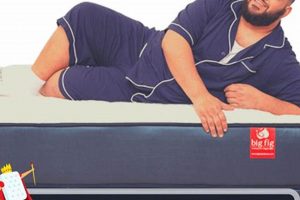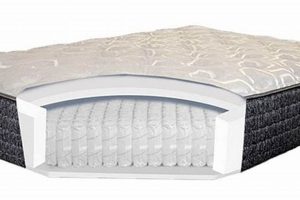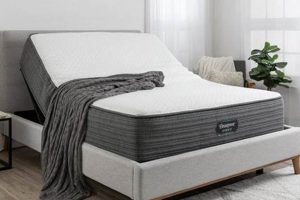A device designed to utilize pressurized hot water vapor to sanitize and refresh sleeping surfaces is invaluable for maintaining a hygienic home environment. These devices expel steam to loosen dirt, eliminate allergens, and diminish unpleasant odors embedded within the fabric. For example, a homeowner might employ such a device to remove dust mites and lingering sweat residue from a bed after years of use.
Employing such a device offers significant advantages, including improved indoor air quality and a reduction in potential allergens that can exacerbate respiratory issues. Historically, methods for cleaning mattresses were limited to surface treatments and sunshine exposure. However, the advent of steam-based technology provides a more effective and efficient solution for deep cleaning and sanitizing.
The subsequent sections will delve into crucial factors to consider when selecting one of these devices, including tank capacity, heat-up time, and available attachments. Further discussion will cover appropriate usage techniques and safety precautions to ensure optimal cleaning performance and longevity of the mattress.
Tips for Selecting and Using a Mattress Steam Cleaning Device
Optimizing mattress hygiene requires careful consideration when selecting and employing a steam-based device. The following tips will guide users toward informed decisions and effective cleaning practices.
Tip 1: Prioritize a High-Temperature Output: Ensure the device generates steam at a temperature sufficient to eliminate dust mites and bacteria. Temperatures above 200F (93C) are generally recommended for effective sanitization.
Tip 2: Assess Tank Capacity Relative to Mattress Size: A larger tank capacity reduces the frequency of refills, enabling uninterrupted cleaning of larger mattresses. Smaller tanks may suffice for spot cleaning or single-size mattresses.
Tip 3: Evaluate Available Attachments: Different attachments, such as upholstery nozzles and crevice tools, enhance versatility for reaching tight spaces and cleaning various mattress surfaces. Look for brushes suitable for delicate fabrics.
Tip 4: Consider Heat-Up Time: Shorter heat-up times minimize waiting periods and streamline the cleaning process. Review product specifications to identify devices with rapid heating capabilities.
Tip 5: Employ Distilled Water Exclusively: Using distilled water prevents mineral buildup within the device, extending its lifespan and ensuring consistent steam output. Tap water can introduce damaging impurities.
Tip 6: Test on an Inconspicuous Area First: Before treating the entire mattress, test the steam cleaner on a small, hidden area to ensure the fabric’s colorfastness and avoid potential damage.
Tip 7: Allow Adequate Drying Time: After steam cleaning, allow the mattress to air dry completely to prevent mold or mildew growth. Ensure proper ventilation by opening windows or using a fan.
Effective selection and utilization of a steam cleaning device can significantly improve mattress hygiene and overall indoor air quality. Adhering to these guidelines promotes optimal cleaning outcomes and prolongs the lifespan of both the mattress and the cleaning device.
The subsequent sections will explore maintenance procedures for the selected device, ensuring continued performance and preventing costly repairs.
1. Steam Temperature
The efficacy of a device for sanitizing sleeping surfaces is intrinsically linked to the steam temperature it achieves. Elevated temperatures serve as the primary mechanism for eliminating dust mites, bacteria, and other allergens embedded within mattress fibers. If the steam temperature is insufficient, these contaminants may survive the cleaning process, thereby negating the intended hygienic benefit. For example, a device that only reaches 150F (66C) may not effectively kill dust mites, whereas one operating above 200F (93C) offers a greater likelihood of complete sanitization.
The correlation between steam temperature and the effectiveness of mattress sanitization is demonstrable in various real-world scenarios. Hospitals, for instance, prioritize high-temperature steam cleaning to minimize the risk of infection transmission between patients. Similarly, hotels aiming to maintain a high standard of cleanliness rely on devices capable of generating sufficiently hot steam to eliminate bed bugs and other pests. The practical significance of understanding this relationship lies in the ability to make informed purchasing decisions, ensuring that the chosen device aligns with the intended purpose of mattress sanitation.
In summary, steam temperature is a critical determinant of a device’s capacity to effectively sanitize a mattress. A lower temperature undermines the hygienic benefits, whereas a higher temperature enhances allergen and pathogen removal. Choosing a device that prioritizes sufficient steam temperature is therefore essential for achieving optimal mattress cleanliness and promoting a healthier sleeping environment.
2. Tank Capacity
The reservoir size of a steam device directly impacts its functionality in the context of mattress maintenance. Tank capacity dictates the operational duration without requiring a refill, thereby influencing the efficiency and practicality of the cleaning process.
- Coverage Area per Fill
Tank capacity determines the surface area that can be treated with a single water fill. Smaller tanks necessitate frequent refills, which can interrupt the cleaning process, particularly when addressing larger mattresses. A device with a larger tank allows for uninterrupted cleaning of a king-size mattress, minimizing downtime and maximizing cleaning effectiveness.
- Impact on Cleaning Time
Frequent refills due to a small tank capacity extend the overall cleaning time. The time spent refilling and reheating the water detracts from the actual cleaning process, making it less efficient. In contrast, a larger tank reduces the frequency of such interruptions, allowing for a more streamlined and time-saving cleaning experience. Consider the device’s operational run time, a spec often directly proportional to tank capacity, as a key factor in optimizing cleaning time.
- Device Portability Considerations
Tank capacity often correlates with the overall size and weight of the device. Larger tanks generally result in heavier and potentially less portable units. This trade-off between capacity and portability must be considered based on individual cleaning needs and storage space availability. A handheld device with a small tank might be suitable for spot cleaning, while a larger, wheeled unit with a high-capacity tank is better suited for whole-mattress cleaning.
- Water Level Monitoring
Certain
devices feature water level indicators, providing a visual cue of the remaining cleaning time before a refill is required. This feature, often more prevalent in devices with larger tanks, allows for better planning and execution of the cleaning process. The absence of a water level indicator can lead to unexpected interruptions, especially with smaller tank capacities.
Tank capacity is a key determinant when evaluating a steam cleaning device. The ideal tank size balances the need for extended cleaning time with considerations of device portability and ease of use. A thorough assessment of the interplay between tank capacity and cleaning requirements is paramount for selecting a device well-suited for effective mattress maintenance.
3. Attachment Variety
The versatility of a steam cleaning device is significantly enhanced by the array of attachments it offers, directly impacting its effectiveness on various mattress surfaces and conditions. The inclusion of specialized nozzles, brushes, and tools allows for targeted cleaning, thereby improving the overall outcome. A device lacking diverse attachments may prove inadequate for addressing the varied contours and materials present in modern mattresses. For instance, a crevice tool is essential for reaching seams and edges where dust mites and allergens accumulate, while a larger upholstery brush facilitates efficient cleaning of broad, flat surfaces. Without such specialized tools, a device may be unable to provide a comprehensive cleaning solution.
The availability of different attachments allows for adaptation to specific cleaning needs, extending the device’s utility beyond mere surface-level treatment. For example, a triangular brush can be more effective at cleaning corners and edges than a standard rectangular nozzle. Moreover, some attachments are designed for specific materials, such as delicate fabrics or heavily soiled areas. The presence of attachments designed for particular tasks can prevent damage and enhance cleaning performance. A device with a wide range of attachments minimizes the need for additional cleaning tools and provides a more complete solution for mattress hygiene. An example of practical application is selecting a steam cleaner that comes with a flexible hose and detail brushes to reach tight corners and crevices around mattress buttons or embellishments.
In essence, a device offering a wider selection of attachments is more likely to provide a comprehensive and effective solution for mattress cleaning. This adaptability ensures that different areas and materials are addressed appropriately, leading to improved hygiene and a longer mattress lifespan. A diverse set of attachments indicates a greater focus on user needs and enhances the overall value of the device. Therefore, when evaluating a steam cleaning device, consider attachment variety as a key indicator of its ability to deliver thorough and customized cleaning results.
4. Fabric Compatibility
The selection of a suitable steam cleaning device for mattresses is inextricably linked to the material composition of the mattress itself. A device ill-suited to a particular fabric can result in irreversible damage, discoloration, or degradation of the material’s structural integrity. The consequence of neglecting fabric compatibility may extend beyond mere aesthetic concerns, potentially compromising the mattress’s support and comfort levels. As an example, a high-temperature steam application on a memory foam mattress lacking protective fabric layers could lead to the foam’s premature breakdown. Thus, fabric compatibility is not merely a peripheral consideration, but a fundamental prerequisite for determining the “best steam cleaner for mattress.”
Understanding the various fabric types commonly used in mattress construction, such as cotton, linen, polyester blends, and specialized performance fabrics, is essential. Each material exhibits different tolerances to heat and moisture. A cleaning device deemed optimal for a durable cotton cover may be entirely unsuitable for a delicate silk or wool blend. Furthermore, the presence of synthetic fibers can influence the fabric’s response to steam. Many modern mattresses incorporate treatments like fire retardants or stain repellents, which can be adversely affected by improper steam cleaning. For example, steam cleaning a mattress treated with a water-based fire retardant using excessive moisture may compromise the retardant’s efficacy. Therefore, a proper evaluation of the steam cleaner’s adjustable temperature settings and steam output controls is crucial for ensuring fabric safety.
In conclusion, fabric compatibility is an indispensable criterion in the evaluation of a suitable steam cleaning device for mattress maintenance. Ignoring this consideration can lead to irreversible damage, undermining the very purpose of the cleaning process. The “best steam cleaner for mattress” is therefore not simply the most powerful or feature-rich device, but the one that aligns precisely with the material properties of the mattress to be cleaned, preserving its integrity and extending its lifespan. Adherence to material-specific guidelines and careful device selection is paramount for achieving optimal results and safeguarding the investment in a quality mattress.
5. Ease of Use
The practical effectiveness of any cleaning device hinges significantly on its operational accessibility. A device, regardless of its technical capabilities, becomes largely irrelevant if it presents undue complexity during its intended application. In the specific context of mattress maintenance, a complicated steam cleaning device is less likely to be used regularly or correctly, negating its potential benefits. The connection between ease of use and the designation of “best steam cleaner for mattress” is, therefore, not merely a matter of convenience but a core determinant of its actual performance over time. A device that is simple to set up, operate, and maintain encourages consistent and proper utilization, thereby maximizing its impact on mattress hygiene and longevity. For instance, a steam cleaner with an intuitive control panel and lightweight design is far more likely to be used frequently, leading to better results compared to a bulky, cumbersome device with confusing settings.
Consider the implications of complex assembly processes, difficult-to-fill water tanks, or unclear operating instructions. These factors can significantly deter users from consistently employing the device as recommended. Regular mattress maintenance is crucial for allergen control and extending the lifespan of the mattress, and a device that complicates this process undermines its purpose. Real-world observations indicate that consumers often revert to less effective, simpler methods if a cleaning tool proves too challenging to use. Devices with ergonomic handles, easily accessible controls, and straightforward cleaning procedures are thus more likely to become integral components of a regular cleaning routine. The practical significance lies in recognizing that the “best steam cleaner for mattress” is not only characterized by its technical specifications but also by its user-centered design that promotes frequent and proper use.
In conclusion, ease of use is a critical, albeit
often overlooked, attribute when evaluating a steam cleaning device intended for mattress maintenance. A device that is inherently user-friendly encourages consistent application, maximizing its impact on mattress hygiene and longevity. The designation of “best steam cleaner for mattress” must therefore incorporate a thorough assessment of the device’s accessibility, intuitive design, and overall operational simplicity. Overlooking this aspect can render even the most technologically advanced devices functionally ineffective, hindering their intended purpose and diminishing their value to the end-user. The true measure of a successful steam cleaning device lies not just in its capabilities but also in its usability, ensuring that it becomes an indispensable tool for maintaining a clean and healthy sleeping environment.
Frequently Asked Questions About Mattress Steam Cleaning
The subsequent section addresses common inquiries concerning steam-based mattress cleaning, providing clarity and dispelling potential misconceptions.
Question 1: How frequently should a mattress be steam cleaned?
The optimal frequency for steam cleaning a mattress depends on several factors, including usage patterns, allergy sensitivities, and pet ownership. In general, steam cleaning every six months is a reasonable guideline for maintaining hygiene. Individuals with allergies or respiratory issues may benefit from more frequent cleaning, perhaps quarterly. If pets are allowed on the bed, monthly cleaning might be necessary.
Question 2: Can steam cleaning damage a mattress?
Improper steam cleaning techniques can potentially damage a mattress. Excessive moisture penetration without adequate drying can promote mold growth. Additionally, excessively high heat may damage certain synthetic fibers or cause adhesives to break down. It is imperative to follow manufacturer instructions for both the mattress and the steam cleaning device. Testing a small, inconspicuous area before treating the entire mattress is advisable.
Question 3: Is steam cleaning effective against bed bugs?
Steam cleaning can be an effective method for controlling bed bugs, provided the steam reaches a sufficiently high temperature (above 160F or 71C) and penetrates all areas where bed bugs may be hiding. This includes seams, crevices, and folds in the mattress. Repeated treatments are often necessary to eliminate the entire bed bug population. Steam cleaning should be part of a comprehensive bed bug treatment plan, potentially involving professional pest control services.
Question 4: Does steam cleaning remove stains from mattresses?
Steam cleaning can assist in stain removal, but its effectiveness depends on the nature and age of the stain. Fresh stains are generally easier to remove with steam cleaning than older, set-in stains. Pre-treating stains with a suitable cleaning solution before steam cleaning may improve results. For stubborn stains, professional mattress cleaning services may be required.
Question 5: What type of water should be used in a mattress steam cleaner?
The use of distilled water is highly recommended for mattress steam cleaners. Distilled water is free from minerals and impurities that can cause scale buildup and potentially damage the device. Tap water, especially in areas with hard water, can shorten the lifespan of the steam cleaner and reduce its cleaning efficiency.
Question 6: How long does a mattress take to dry after steam cleaning?
Drying time depends on factors such as ambient humidity, room temperature, and the amount of moisture applied during the cleaning process. Generally, a mattress requires several hours to dry completely after steam cleaning. Ensuring adequate ventilation by opening windows or using fans can expedite the drying process. Avoid placing bedding on the mattress until it is completely dry to prevent mold growth.
Careful adherence to best practices and informed decision-making regarding steam cleaning parameters ensures effective and safe mattress maintenance.
The concluding section will summarize the key considerations for optimizing hygiene and device selection.
Concluding Remarks on Optimal Mattress Hygiene
The preceding exploration underscores the multifaceted considerations involved in selecting the “best steam cleaner for mattress.” Factors such as steam temperature, tank capacity, attachment variety, fabric compatibility, and ease of use collectively determine the effectiveness and suitability of a given device. Careful assessment of these aspects is paramount for achieving optimal mattress hygiene and prolonging the lifespan of the sleeping surface.
Prioritizing informed decision-making and diligent application of recommended cleaning practices remains crucial. Investing in a device that aligns with specific mattress characteristics and consistently adhering to appropriate maintenance protocols represents a proactive approach to safeguarding both the sleeping environment and individual well-being. Consistent practice represents the long-term value.


![Top-Rated: Best Mattress for Wall Bed Sleep [Guide] Organic & Natural Mattress Buyer’s Guide: Non-Toxic Sleep Solutions Top-Rated: Best Mattress for Wall Bed Sleep [Guide] | Organic & Natural Mattress Buyer’s Guide: Non-Toxic Sleep Solutions](https://mattressworldpa.com/wp-content/uploads/2025/07/th-7594-300x200.jpg)
![Top: Best Rated Latex Mattress [Reviews & Guide] Organic & Natural Mattress Buyer’s Guide: Non-Toxic Sleep Solutions Top: Best Rated Latex Mattress [Reviews & Guide] | Organic & Natural Mattress Buyer’s Guide: Non-Toxic Sleep Solutions](https://mattressworldpa.com/wp-content/uploads/2025/07/th-7593-300x200.jpg)



![Ultimate Guide: Best Mattress Latex [2024 Review] Organic & Natural Mattress Buyer’s Guide: Non-Toxic Sleep Solutions Ultimate Guide: Best Mattress Latex [2024 Review] | Organic & Natural Mattress Buyer’s Guide: Non-Toxic Sleep Solutions](https://mattressworldpa.com/wp-content/uploads/2025/07/th-7589-300x200.jpg)